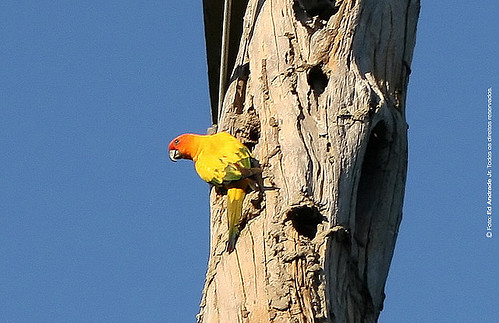Sun conures in Boa vista
 Friday, September 12, 2008 at 4:00
Friday, September 12, 2008 at 4:00  Sun conure in boa vista. Image by Ed Andrade Jr Although I have never seen much fact in the many accusations that have been made towards introduced city parrots, as a conservation biologist I do prefer threatened parrots to populate cities in their native ranges, where they are most appropriate. Today, trough our flickr pool, we discovered just such a threatened parrot: Sun Conures (Aratinga solstitialis) are colonizing the city of Boa Vista in the state of Roraima, Brazil which is located in the conures natural range.
Sun conure in boa vista. Image by Ed Andrade Jr Although I have never seen much fact in the many accusations that have been made towards introduced city parrots, as a conservation biologist I do prefer threatened parrots to populate cities in their native ranges, where they are most appropriate. Today, trough our flickr pool, we discovered just such a threatened parrot: Sun Conures (Aratinga solstitialis) are colonizing the city of Boa Vista in the state of Roraima, Brazil which is located in the conures natural range.
The Sun conure has recently been listed as Endangered on the 2008 IUCN Red List, as evaluated by BirdLife International - the official Red List Authority for birds for IUCN. The estimated population size of 1,000-2,500 is said to be decreasing. The birds, which naturally occur in Guyana, Brazil and formally possibly in Surinam, have suffered dearly from the international bird trade.
The new observations of Sun conures in Boa vista spark hope for a rapid population recovery. The reintroduction of the closely related Golden capped Conure (Aratinga auricapilla) near Salvador – Bahia, Brazil - has been successful in establishing a breeding population for that populated area.
 Family of Sun conures checking out their urban nest. Image by Ed Andrade Jr.As we at City Parrots have seen for so many parrot species around the world, cities provide save and productive environments for parrots. The population growth of many of these conure type parrots in urban areas has been phenomenal. Parrots are save in city areas because urban people do not generally depend on wildlife for their sustenance or nutrition and usually thus ignore the urban avifauna. In contrast for rural people, wildlife is one of the few means to supplement their diet and income and they will actively seek out the local avifauna for trade and game. So the threat coming from the wild bird trade is generally lower in cities. Something this and other parrots threatened by the wild bird trade should benefit from.
Family of Sun conures checking out their urban nest. Image by Ed Andrade Jr.As we at City Parrots have seen for so many parrot species around the world, cities provide save and productive environments for parrots. The population growth of many of these conure type parrots in urban areas has been phenomenal. Parrots are save in city areas because urban people do not generally depend on wildlife for their sustenance or nutrition and usually thus ignore the urban avifauna. In contrast for rural people, wildlife is one of the few means to supplement their diet and income and they will actively seek out the local avifauna for trade and game. So the threat coming from the wild bird trade is generally lower in cities. Something this and other parrots threatened by the wild bird trade should benefit from.
The observations Of Sun conures in Boa Vista were done by Ed Andrade Jr. and his wife Larissa Diehl, who both live there. They observed 6-7 individuals of these conures close to their house playing on utility poles (photos). They could not confirm they were using the poles as nests but do believe the population is reproducing. Andrade also states that the species is not often seen in the surrounding countryside, confirming the endangered status of this once fairly common bird. Andrade and Diehl are keeping the exact location of their observations a secret for fear of attracting poachers.
The small population suggest that the population has just started and is only one or two generations old. To prevent inbreeding and the so-called “founder effect” it would be advisable to supplement the population with genetically unrelated individuals. Like in Salvador newly confiscated birds could be rehabilitated to join the flock. Or - as this species is prevalent in aviculture – captive reared birds could be introduced. A genetically diverse population has a better change at rapid population growth.
 Sun conure in Boa Vista. Image by Ed Andrade Jr We welcome further observations of these rare parrots in Boa Vista and invite the conservation community to assist this fledgling population.
Sun conure in Boa Vista. Image by Ed Andrade Jr We welcome further observations of these rare parrots in Boa Vista and invite the conservation community to assist this fledgling population.

